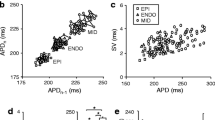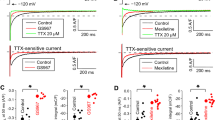Abstract
The cellular electrophysiological effects of EGIS-7229 (5-chlor-4-[N-(3,4-dimethoxy-phenyl-ethyl)-amino-propylamino]-3(2H)-pyridazinone fumarate), a novel antiarrhythmic agent, was studied using conventional microelectrode techniques in canine cardiac Purkinje fibers and papillary muscle preparations obtained from man, rabbits and guinea pigs. Low concentration of EGIS-7229 (3 μmol/l) selectively lengthened action potential duration (both APD50 and APD90) in all preparations. The effect of higher concentrations (30–100 μmol/l) of EGIS-7229 on action potential duration was variable depending on the preparation studied: in rabbit and human papillary muscles both APD50 and APD90 were lengthened, in canine Purkinje fibers APD90 was lengthened but APD50 was shortened, while in guinea pig papillary muscles both APD50 and APD90 were shortened by high concentrations of the drug. At these higher concentrations EGIS-7229 also decreased the maximum velocity of action potential upstroke (V max) and depressed the plateau of action potentials without affecting the resting membrane potential or action potential amplitude.
Both reduction of V max and lengthening of APD were frequency dependent. The former effect was more prominent at higher pacing frequencies, while the latter was more pronounced at lower driving rates. In guinea pig papillary muscle, the time constant of recovery from V max-block was 719 ± 33 ms (n = 18) and the rate of onset of the block was 1.81 ± 0.06 AP–1 (n = 16) in the presence of 100 μmol/l EGIS-7229. EGIS-7229 had a complex action on refractoriness in guinea pig papillary muscles: ERP was lengthened at low concentrations (3 to 10 μmol/l), unchanged at 30 μmol/l and shortened at 100 μmol/l. The ratio of ERP/APD90, however, was significantly increased at concentrations higher than 3 μmol/l.
In canine Purkinje fiber, when the delayed rectifier K current (IK) was blocked by d-sotalol (60 μmol/l) and APD was shortened back to its control value by additional application of nicorandil (15 μmol/l), APD was not affected by 3 μmol/l but was shortened by 30 μmol/l of EGIS-7229. 100 μmol/l EGIS-7229 shortened APD in guinea pig papillary muscle. This effect of EGIS-7229 was effectively prevented by nifedipine pretreatment (10 μmol/l). In this preparation, EGIS-7229 also decreased the V max of the slow action potential, evoked in the presence of 20 mmol/l external K+ plus 0.5 mmol/l Ba2+.
It is likely that EGIS-7229 at low concentrations blocks IK in human, canine, rabbit and guinea pig cardiac preparations, but at higher concentrations also inhibits Ca and Na currents. Therefore, EGIS-7229 appears to carry mixed class III, IV and IB antiarrhythmic properties.
Similar content being viewed by others
Author information
Authors and Affiliations
Additional information
Received: 8 July 1996 / Accepted: 23 October 1996
Rights and permissions
About this article
Cite this article
Pankucsi, C., Bányász, T., Magyar, J. et al. Electrophysiological effects of EGIS-7229, a new antiarrhythmic agent, in isolated mammalian and human cardiac tissues. Naunyn-Schmiedeberg's Arch Pharmacol 355, 398–405 (1997). https://doi.org/10.1007/PL00004960
Issue Date:
DOI: https://doi.org/10.1007/PL00004960




